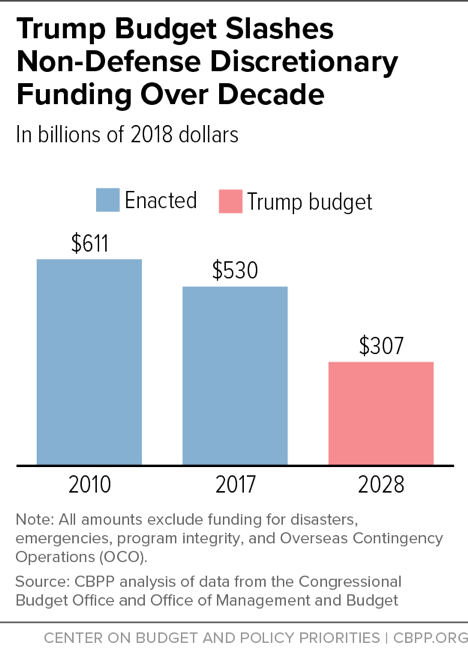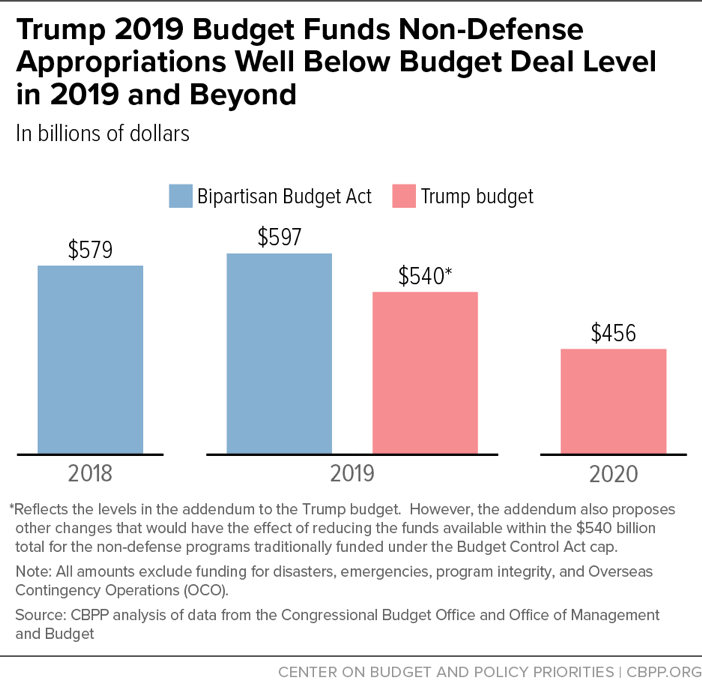- Home
- Trump Budget Would Cut Non-Defense Progr...
Trump Budget Would Cut Non-Defense Programs Deeply in 2019 and Beyond
The President’s non-defense budget moves in a completely opposite direction from legislation enacted on a bipartisan basis just last week.In his 2019 budget, President Trump once again proposes steady and massive cuts to non-defense appropriations (“non-defense discretionary” funding or NDD), which fund a wide range of priorities such as education, job training, infrastructure, housing assistance, and scientific research. These cuts would leave funding substantially below the 2019 level agreed to in the recent bipartisan budget agreement and grow even larger in subsequent years.
Under the Trump plan, regular non-defense appropriations would fall from year to year in each of the next ten years, even before adjustment for inflation. The cumulative effect would be dramatic. By 2028, these appropriations would be 42 percent below 2017, the most recently enacted level, and 50 percent below 2010 in inflation-adjusted terms. (See Figure 1.)
The decrease is even more dramatic when spending is measured relative to the size of the economy, as a percent of gross domestic product (GDP), a common way of looking at budget changes over time. The Administration projects that non-defense discretionary spending would fall to 1.3 percent of GDP in 2028 under its budget — compared to 3.2 percent last year and an average of 3.8 percent over the period from 1962-2016. In fact, the percentages reached under the Trump budget by early next decade would be the lowest seen since the Hoover Administration.
The President’s non-defense budget moves in a completely opposite direction from legislation enacted on a bipartisan basis just last week, which raised the limits on both defense and non-defense appropriations for 2018 and 2019 well above the levels set under the 2011 Budget Control Act (BCA) and the sequestration cuts it imposes, as policymakers continued to recognize that those levels were simply too low to meet national needs. The Trump budget, however, calls for appropriating considerably less in 2019 for non-defense programs than the agreement specifies, and in subsequent years it would cut these appropriations well below what even full sequestration would require.
Because the President’s budget had been finalized and sent to the printer before the bipartisan budget agreement was announced last week, the Trump Administration has provided a budget “addendum” for 2019 that recognizes the agreement — but only to a limited extent.[1] In its addendum, the Administration lays out about $75 billion in additions to its 2019 budget, proposing total NDD funding of $540 billion in 2019. This sounds like a substantial increase, but it applies to a budget that would have cut NDD appropriations $132 billion below the agreement level and $65 billion below what full sequestration cuts would require. So even with the addendum, the Trump plan calls for appropriating $57 billion less in 2019 than the revised non-defense cap enacted last week. (See Figure 2.)
Those figures actually overstate what the Administration is proposing, however, since more than half of the purported additions don’t really increase funding levels. Rather, some involve simply shifting ongoing expenditures that are part of the mandatory spending or overseas contingency operations budget categories into the regular non-defense discretionary category (thus making them subject to the BCA non-defense cap). This increases the number of programs funded under the regular non-defense total, soaking up a share of the additional resources provided in the deal and effectively denying them to programs that are traditionally funded in the category.
Other items in the addendum call for changes to budget rules to end using certain rescissions and other changes to mandatory spending proposals to finance discretionary appropriations — the main effect of which is to make the NDD total appear higher than it would be under current rules. Without these devices, the budget’s non-defense total would be below the 2019 sequestration level.
A number of changes included in the budget addendum increase funding, but often the increase simply involves reversing a cut made in the main 2019 budget proposal. For example, the main 2019 budget calls for cutting formula grants to states for operating job training programs by 40 percent below the 2017 amount. The addendum’s increase eliminates that proposed cut and instead freezes funding at the 2017 level.
The bottom line is that 2019 NDD funding under the Trump budget — including the addendum and its reshuffling between budget categories and accounting changes — would still be $39 billion below the 2018 level as revised by the bipartisan budget agreement. And the budget calls for reducing NDD funding in 2020 by another $84 billion. The 2020 level basically puts NDD back on track for the Administration’s original budget proposals for 2018 and 2019, which called for immediate and sustained deep cuts in NDD. In contrast, the Trump budget includes the full increases in defense appropriations called for in the budget agreement and continued increases in subsequent years.
Within the non-defense totals, the President once again proposes steep cuts to areas that invest in the future, assist low-income households, and protect the environment, among others. For example, even after the addendum, the budget reduces aid to elementary and secondary education, cuts rental assistance programs, eliminates the Low Income Home Energy Assistance Program and Community Development Block Grant, cuts or eliminates several infrastructure investment programs, and reduces the Environmental Protection Agency budget by about one-quarter.
These steadily growing cuts that the Trump plan lays out for the next ten years run counter to the growing sentiment in Congress that cuts under the BCA have been too large and damaging and should be reversed. To the extent that the Trump budget’s dramatic reductions in non-defense appropriations are unrealistic, they represent a gimmick that helps the Administration understate the deficits that its budget would produce. But these cuts are also significant in making clear the direction in which the Administration wishes to take the federal budget, both in its totals and its priorities, and the kind of things the Administration and its allies will be pressing for as Congress considers appropriations for both 2018 and 2019.
Trump Budget Deeply Cuts Health, Housing, Other Assistance for Low- and Moderate-Income Families
End Notes
[1] The Administration has also sent Congress a set of revisions to its 2018 budget, which was proposed last year, in response to the bipartisan agreement’s increase in the 2018 appropriations caps. The 2018 revisions raise similar issues as those involving the 2019 addendum.
More from the Authors


